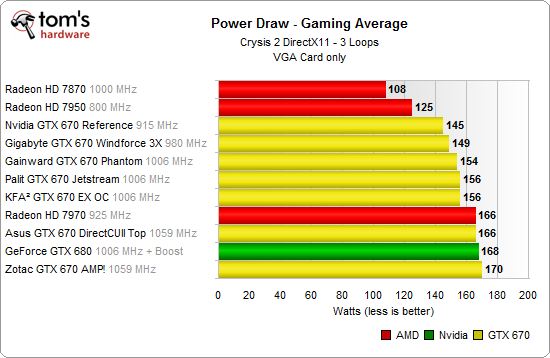Seven GeForce GTX 670 Cards, Benchmarked And Reviewed
We have seven GeForce GTX 670 cards. Which is fastest? Which is quietest? Each one swaggers onto the scene ready to prove its worth to your wallet. We emphasize thermals, acoustics, and design in this many-way shoot-out based on Nvidia's capable GK104.
Power Consumption
When we compare the power draw of our seven GeForce GTX 670s, their differences are a few watts at most, except for under load. This variation is most likely traceable to the design of the DC-DC converters and use of non-reference cooling fans, rather than core components like the GPU and memory modules.
We haven't seen AMD bring down the power consumption of its Radeon cards during Blu-ray movie playback yet, and, during gaming, the Kepler-based cards are more efficient as well.
When we look at power measurements other than those our stress test generates, an interesting picture emerges.
The Radeon HD 7950's average power consumption isn’t bad at all, even if it achieves lower performance. If this card was overclocked to approach the GeForce GTX 670's performance, its efficiency would plummet. With that said, the GeForce GTX 670 and 680 only win efficiency victories when we stress all cards as hard as possible.
And by the way, a GeForce GTX 670 overclocked to its limit draws more power than a GeForce GTX 680 at its stock settings, despite almost equal gaming performance.
Benchmarking a compute workload gives us a much different picture. Under full load, both Kepler-based cards draw much less power than AMD's Tahiti-based solutions. Keep in mind, though, that the GeForce GTX 600-series cards are severely handicapped in compute-oriented tasks compared AMD's boards based on its GCN architecture.
It also becomes quite clear that overclocking the GeForce GTX 670 cards results in disproportionately high power draw compared to the performance gained in our compute test. Zotac's Zotac ZT-60302-10P draws 57 W more than the reference card, approaching a GeForce GTX 680 without attaining the 680's performance.
Get Tom's Hardware's best news and in-depth reviews, straight to your inbox.
This also makes us wonder why Zotac uses two six-pin power connectors. In our torture test, the card draws 215 W. Any overclocking beyond that would quickly exceed the connectors’ spec for maximum electrical current.
The most interesting card for compute applications seems to be AMD's Radeon HD 7870, which is even more efficient than the Radeon HD 7950. But our observations about overclocking the GeForce GTX 670 apply here, too: don't go overboard, lest efficiency suffer. With that in mind, the Radeon HD 7950 could be a more efficient choice than the Radeon HD 7970 or any Kepler-based card.
What's The Verdict?
- If bleeding-edge gaming is your passion, the GeForce GTX 670 has an edge. Once Catalyst 12.7 goes live, we think the Radeon HD 7970 becomes a more attractive choice, too.
- If compute-oriented applications are of increasing importance to you, then AMD's Radeon-based cards are your first and only choice at this point. This has taken a back seat for Nvidia on the desktop, and as it tries to protect its Quadro and Tesla portfolios, AMD enjoys a significant advantage.
Nvidia's cards are not as far ahead in efficiency as the stress test might indicate. Apart from Blu-ray playback, which AMD really bungles, the current GCN-based GPUs are better than some forum posts and other reviews allege, even though they do fall short of Kepler.
Current page: Power Consumption
Prev Page Sound Level Comparison, With Video Next Page Seven Solid GeForce GTX 670s, But Three Stand Out
Igor Wallossek wrote a wide variety of hardware articles for Tom's Hardware, with a strong focus on technical analysis and in-depth reviews. His contributions have spanned a broad spectrum of PC components, including GPUs, CPUs, workstations, and PC builds. His insightful articles provide readers with detailed knowledge to make informed decisions in the ever-evolving tech landscape
-
user 18 On the Gigabyte card's page:Reply
During the course of our testing, we effortlessly set this card to run at 1059 MHz, so we're not sure why Gigabyte held back so much. During testing, we overclocked this card to 1059 MHz quite easily, so we are somewhat surprised by the conservative factory overclock.
This seems to be saying the same thing twice. Error, or am I missing something? -
FormatC Reply
The roundup was published in German on May 22, 2012:10445301 said:Where is the msi gtx 670 power edition?
http://www.tomshardware.de/Nvidia-Geforce-GTX-670-Roundup,testberichte-241027.html
Sorry, but at this time (and 4 weeks later too) MSI was unable to deliver one of this cards. When MSI starts so late with this cards, then this is not our fault. ;)
-
user 18 Also, the second chart on the 'Sound Level and Temperature: Overclocked' page is missing the 'Mhz' label on the speed for the Palit card. It should read '1059 Mhz', while it reads only '1059'.Reply -
LonelyMan I'd like to see one for the 680s too, in which the 680 classified and lightning will be present, including others. :DReply




